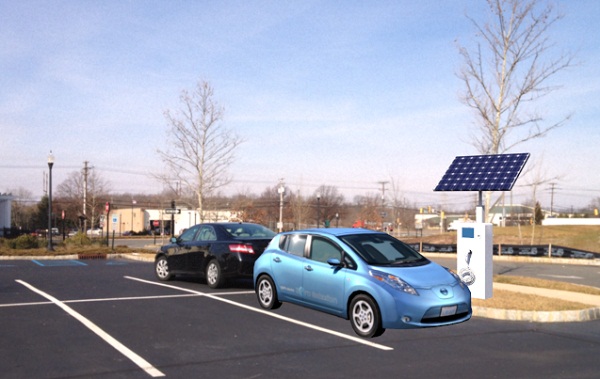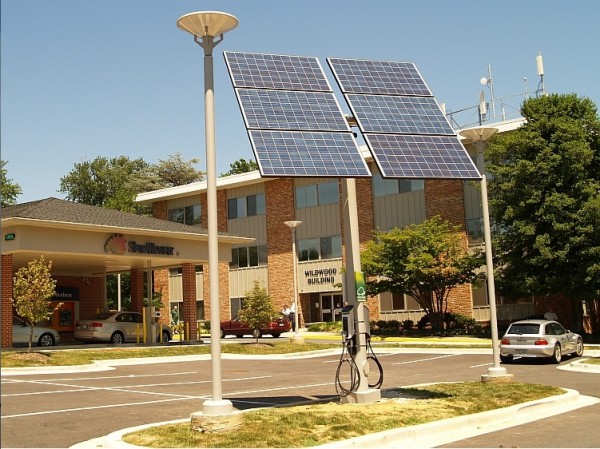When Princeton Satellite Systems put on a little demo of its solar-powered EV charging station recently in New Jersey, word got around.
Ted Bohn, principal electrical engineer at the Advanced Powertrain Research Facility at the Argonne National Laboratory, heard about the SunStation. He quickly passed on word to Rob Lundahl, an executive at Advanced Technology and Research, a Maryland company that makes and sells a grid-tied solar-powered EV charging station (two of which are installed and operating).

What piqued Bohn’s and Lundahl’s interest was that Princeton Satellite was doing an EV charging station untied to the grid. This would be, the Plainsboro, N.J., company said, the “first 100 percent green charging station for electric vehicles.” It would rely entirely on a fixed-tilt, 1.6-kilowatt photovoltaic array to charge a battery pack with a capacity of 12 kilowatt-hours, making it possible to “charge EVs 24 hours a day.”
A few media outlets picked up the story, but there was a lingering unasked — and unanswered — question: Would something like this really work?
Not very well, it turns out.
“Here’s the thing: Without a grid connection, unless you have a very big array with lots of battery storage, you’ll be quite limited in how much vehicle charging you can accomplish,” ATR’s Lundahl told me when I spoke to him on the phone. “There’s just some basic math here.”

The math is that a 1.6 kW fixed-tilt array in, say, Princeton Satellite’s hometown of Plainsboro, N.J., will produce an average of 6 kilowatt-hours of power a day in May, the most productive month for that location. In December, solar power production would average around 3.5 kWh, according to the National Renewable Energy Laboratory’s PV Watts calculator.
So in May, it would generally take around two days, assuming there was no discharging, to bring the SunStation battery pack up to its 12 kWh capacity. And in January, it would take nearly four days.
Meanwhile, a Chevy Volt has a 16 kWh battery and a Nissan Leaf a 24 kWh battery.
So boosting a Nissan Leaf from a 25 percent charge state to 75 percent charge state – around 12 kWh of power, which would take around 3.5 hours to deliver on a level 2 dock — would deplete the SunStation battery. And then what if night falls, or the clouds move in? Solar power production ceases. Or what if someone pulls up in a Mitsubishi i, needing a charge?
Twenty-four hour EV charging?
“Clearly there would be limits to how much charging could be done,” Eloisa de Castro, Princeton Satellite Systems’ chief mechanical engineer, told me. “That’s always going to be the case. But we think for someone parking while shopping, or for a company that wants to make a statement about its green values, a system like this could a great thing.”
De Castro also mentioned the SunStation’s 3.2-kilowatt array, which would be able to charge two cars at once, would be a more substantial energy producer. But that still seems to be an extremely small amount of power – certainly it wouldn’t be possible for users to count on their being power available when they pull in for a charge.
Lundahl said that over at ATR, they’re pretty happy – and their customers are, too – with their grid-tied solar charging stations.
“With the pole design we have a small footprint, and using tracking maximizes power production,” he said. “What we’re seeing is, people are drawn to these charging stations. They like to see the solar. So it’s a great marketing tool, but that’s not all it is. It produces real power that makes a contribution to the grid and has value. And, of course, no matter what the weather conditions or day or night, it can meet a driver’s charging needs.”
The company said it has a third system about to go in, and has bids out to other potential buyers. An ATR charging station costs $15,000 for all the gear except the level 2 charger. That component starts at around $1,500. The highly variable cost of installation goes on top of all that.

ATR had been hoping to strike a deal with General Motors to get its setup at Chevy Volt dealerships, but GM ended up making an equity investment in Sunlogics, since renamed ViSole Energy, for solar-powered EV charging stations. Visole’s “Green Zone” systems are big canopy structures; the company says a “a 4 or 8 space solar canopy on average generates 32,000 kWh per year … enough electricity to charge the Chevrolet Volt 4,500 times a year, which is equivalent to 12 cars receiving a full charge a day.”
Lundahl said one issue with the big canopy structure is that it can be difficult to fit on a lot while also making sure it’s properly oriented to capture sunlight.
As for what he thought it would take to do a true, reliable solar-only integrated charger, Lundahl said such a system would need the ability to produce around 15-20 kWh per day on average, which would require at least a 5-kW array in most places. Then you’d need at least 100 kWh of battery storage, which would take up a lot of space, not to mention be very expensive.
Princeton Satellite Systems told me the smaller SunStation would sell for $35,000 and the larger one $55,000.
Bohn, from the Argonne Lab, said he couldn’t take a formal position on the SunStation, but did offer this thought: “On a cost benefit perspective, the Princeton Satellite solar powered charging station has a very long return on investment for delivered energy/convenience when compared to more traditional energy delivery methods.”